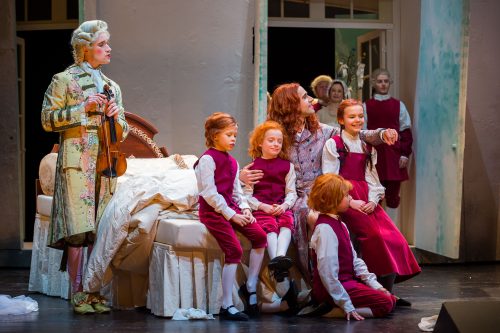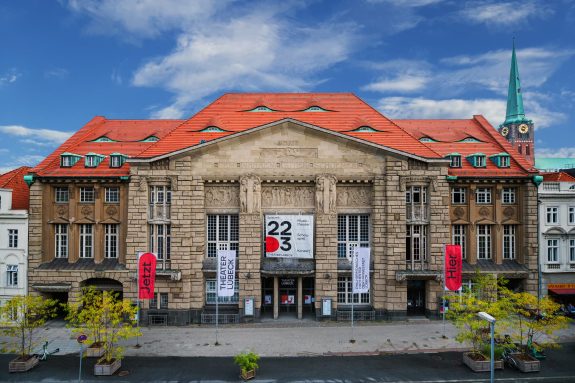 Germany Mozart, Le nozze di Figaro: Soloists, Chorus and Extras of Theater Lübeck, Takahiro Nagasaki (fortepiano), Philharmonic Orchestra of Hansestadt Lübeck / Stefan Vladar (conductor). Theater Lübeck, 1.4.2024. (DM-D)
Germany Mozart, Le nozze di Figaro: Soloists, Chorus and Extras of Theater Lübeck, Takahiro Nagasaki (fortepiano), Philharmonic Orchestra of Hansestadt Lübeck / Stefan Vladar (conductor). Theater Lübeck, 1.4.2024. (DM-D)

Production:
Director – Stephen Lawless
Stage and Costume design – Adrian Linford
Lighting design – Falk Hampel
Choreography – Ulla Benninghoven
Dramaturgy – Judith Lebiez
Chorus director – Jan-Michael Krüger
Cast:
Figaro – Florian Götz
Susanna – Andrea Stadel
Count Almaviva – Jacob Scharfman
Countess Almaviva – Joo-Anne Bitter
Cherubino – Frederike Schulten
Marcellina – Virginia Felicitas Ferentschik
Bartolo – Rúni Brattaberg
Basilio / Don Curzio – Noah Schaul
Barbarina – Natalia Willot
Antonio – Steffen Kubach
In this revival of the 2023 production of Mozart’s Le nozze di Figaro, all aspects of the production came together in full harmony to create an immensely joyful experience for eyes and ears alike. Director Stephen Lawless told the opera’s story, with its many twists and turns, with admirable clarity and attention to detail. For example, Cherubino hid behind and under the covers of the double bed that Figaro and Susanna had acquired for their room. The Count stood out right away, his red hair coiffed to make it look like a wig. Later, when some of the female servants gathered, three or four children with similarly red hair ran up to the man who was clearly their father. This reference to Almaviva and prima nocta served as context for the sexual tension central to the plot: the mothers were quite comfortable with their children and with the Count, and the children with their father, even dutifully running back to their mothers when Almaviva signalled, in passing, that their ‘father-time’ was up. The rococo costumes were beautiful and elaborate, while the wig worn by Basilio, who carried a violin and bow at all times, made his character appear decidedly over the top – perhaps it was a hint at the image of Mozart conveyed by the play and film Amadeus.
The set consisted of a circular construction which on one side represented the interior, such as the room Susanna and Figaro were preparing for themselves or the existing rooms of Countess and Count Almaviva. Turned around, those walls became the canvas for the painting of a vast and beautiful landscape. No matter whether the setting was inside or outside, a number of large doors opened in the circular structure to reveal further windows or doors. Sadly, for the performance I saw, the set had been put together in such a way that the entrances of the singers from the wings, movements behind the closed large doors and backstage work by the stagehands were visible at times – arbitrarily and clearly not intended. This distracted from the action onstage. For the scene in the mansion grounds, the set came apart and thus created a further environment with additional spaces for characters to hide in and eavesdrop. In a clever move, Countess Almaviva’s four-poster bed became a garden pavilion when its curtains were drawn.

Stefan Vladar, head of opera and general music director at Theater Lübeck, made the music a joyful experience for his orchestra, the singers and the audience alike. He paid much attention to the nuances of the score, combining focus, a high level of energy and a general feeling of life and celebration. Witty direction and sensitive conducting brought out the best in the singers. Florian Götz sang Figaro with a firm vocal core providing the basis for much flexibility. Andrea Stadel’s voice was more mature than many a Susanna I have heard over the years. She is not far away from singing the Countess. This brought an interesting additional dimension to the production – both Figaro and Susanna have been in the service of Count and Countess Almaviva for a good number of years, rather than being relative newcomers to their positions in the hierarchy of the household. This allowed for a different, possibly closer, relationship between master/mistress and their respective servants. Stadel excelled in Susanna’s final aria. Jacob Scharfman brought a high level of musicality to his portrayal of Count Almaviva – because of his exemplary breath control he did not have to resort to near-shouting some of the more intricate shorter phrases Mozart composed for his character.
Joo-Anne Bitter started with a potentially problematic, uneven vibrato, but very soon settled into the role of Countess Almaviva and sang the ‘Dove sono’ aria with an admirable, gently flowing, full, warm and resonant voice. Mezzo-soprano Frederike Schulten is a member of the theatre’s opera studio. Cherubino is one of her major roles for this season, and it is a notable achievement. Her acting skills are considerable, her voice fresh and even, supported by a keen sense of rhythm. Casting a younger singer as Marcellina ensures that her part is sung at the level of beauty an older voice may no longer be able to produce. This was true for Virginia Felicitas Ferentschik, who brought out aspects of the role that are lost in many other productions where the part is given to a much-loved singer past her vocal prime. Rúni Brattaberg is a long-standing member of the Lübeck opera company with worldwide guest appearances. His portrayal of Bartolo was assertive and convincing. Noah Schaul made the most of both the roles of Basilio and Don Curzio, as did Natalia Willot as Barbarina and Steffen Kubach as Antonio.
Daniel Meyer-Dinkgräfe
Featured Image: Theater Lübeck © Olaf Malzahn
